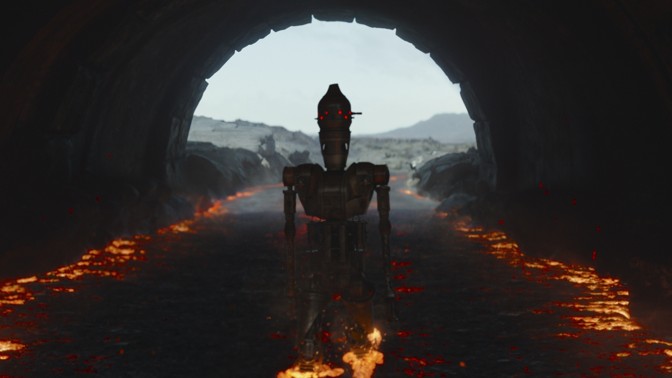With this development, though, The Mandalorian deepened its take on a defining trope of the broader Star Wars franchise—and of the larger fantasy genre that drives so much modern entertainment. If it’s a pulpy thriller involving superpowers and Manichaean conflict, it’s going to feature characters in disguises. Elsewhere in Lucas-land this past week, viewers of The Rise of Skywalker, the final installment of Disney’s movie trilogy, squinted to discern whether Keri Russell was indeed the actor playing the headpieced badass Zorii Bliss. They also watched Kylo Ren repair, rewear, and then re-remove the helmet he manufactured in tribute to the ultimate face-obscured villain of his galaxy: Darth Vader. Earlier in 2019, Marvel concluded its costumed-superhero epic. Joaquin Phoenix caked himself in the makeup of the Joker. HBO’s Watchmen unspooled scary meta-commentary on, really, all of the above costume-wearing vigilantes.
Watchmen in particular tried to address the why of our cultural fascination with masks, and ended up spinning a deep fable about loss, identity, and savior complexes. The Mandalorian uncannily chimes with that show’s insights: The flashbacks of Djarin’s parents trying to hide him as their village was terrorized by battle droids is, cinematographically, similar to Watchmen’s scenes of the Tulsa massacre that inspired generations of black Americans to put on masks and fight evil. But thus far, The Mandalorian has less been a pondering of trauma than a pondering of humanity and nonhumanity. The point of the scene in which Djarin removes his helmet lies in the interaction between him and the IG-11, which hints at Star Wars’s insight on masks and armor: They’re the means by which people try to attain the perfection, and indifference, of machines.
Really, are the metal-masked man Djarin and the metal-made droid IG-11 so unalike? The Mandalorian would, in that moment, say yes. All series long, he has made clear that he distrusts droids. It’s obvious that his distrust stems in part from what happened to his family, but it also stems from what he’s seen as a galaxy-trotting mercenary. In the series premiere, IG-11 arrived as a fearsome bot chasing the adorable creature viewers now call Baby Yoda. Djarin destroyed IG-11 then, but in the seventh episode, the droid returned with a different mission: to protect and nurture. When the Mandalorian’s ally Kuiil, who had reprogrammed the robot, insisted on using IG-11 to safeguard Baby Yoda, the Mandalorian pointed out that it had previously tried to kill The Child. “It was programmed to do so,” Kuiil replied. “Droids are not good or bad. They are neutral reflections of those who imprint them.” The Mandalorian’s reply: “I have seen otherwise.”
The finale served as one long, spectacular vindication of Kuiil’s point of view. IG-11—who looks like a person-shaped antennae and moves with the stop-motion creepiness of a Tool music video—saves the day for the Mandalorian and Baby Yoda multiple times, in stylish action sequences. It blasts; it heals; it sacrifices itself by wading into a lava river and then triggering its self-destruct protocol in front of a squad of Storm Troopers. It even plays therapist, telling the Mandalorian that it senses sadness in his voice. In many relevant ways, the droid, not the human the show is named after, is the hero of The Mandalorian’s finale.
Star Wars fans likely weren’t surprised by the valorization of a bot. The original trilogy’s droid duo, R2-D2 and C-3PO, are just as smart and personality-packed as any human character. But they’ve been programmed to serve, and serve they do—although in idiosyncratic, willful-seeming ways that involve lots of comedy. Rather than encroach on the primacy of the living, as dystopian fables like Terminator and The Matrix fret that sentient computers might someday do, Star Wars’s super-smart robots are extensions of humankind. Episode 7 of The Mandalorian featured a flashback showing how Kuiil reprogrammed IG-11 to be a nurse rather than a murderer, and the sequence made the process sound an awful lot like raising a child. “I spent day after day reinforcing its development with patience and affirmation,” Kuiil says. “It developed a personality as its experiences grew.”
Source link
 Black America Breaking News for the African American Community
Black America Breaking News for the African American Community
